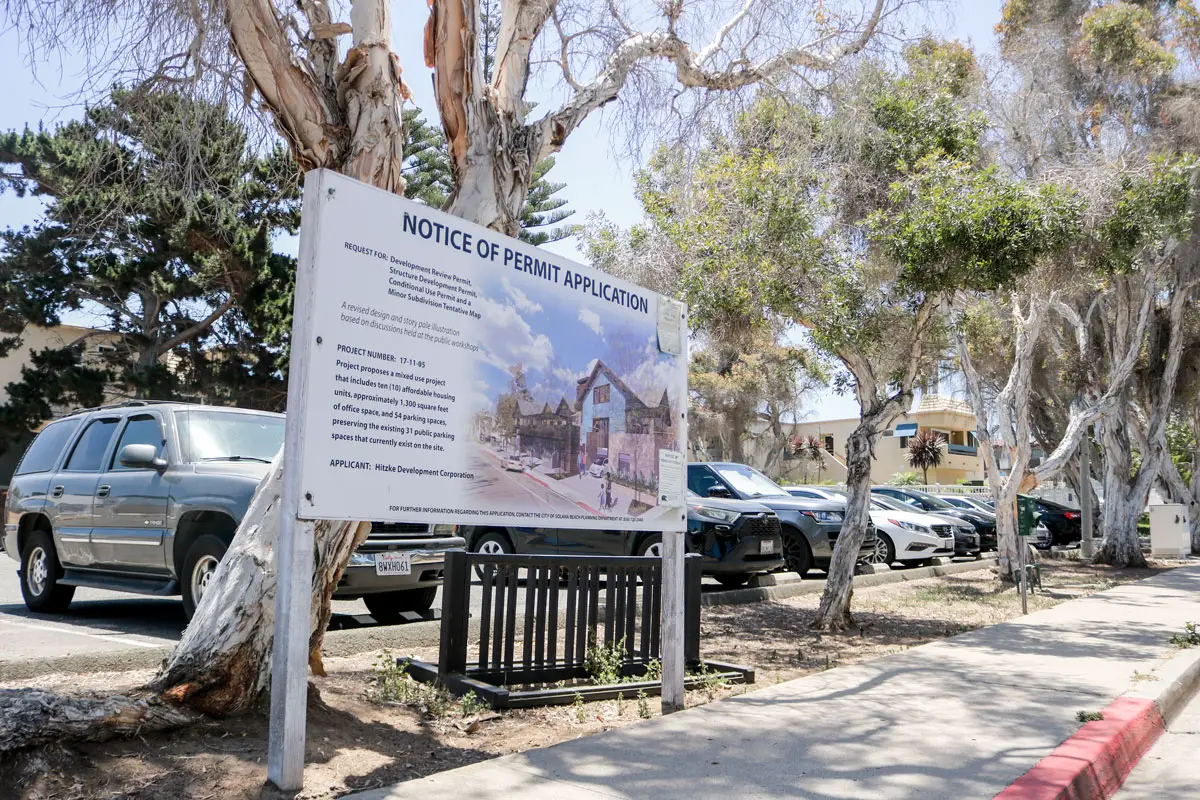SOLANA BEACH — City leaders are preparing to relaunch an affordable housing project in the 500 block of South Sierra Avenue after soaring costs led the former developer to abandon the project at the onset of the COVID-19 pandemic .
Known as The Pearl, the mixed-use affordable housing development was previously slated to be built on a 14,720 square foot city-owned public parking lot and contain 10 multi-bedroom units.
While former developer Hitzke Development Corporation had high hopes for the project, first proposing it to the city in 2009 and receiving approval in 2014, subsequent lawsuits from neighbors set back its progress for years. construction and labor costs increasing significantly during this period.
When crucial state and county development grants were withdrawn due to the higher price tag, Hitzke backed out of his development deal with the city in 2020.
Now, with full funding yet to be identified for the project, city leaders say they want to issue a new request for proposals to find a developer willing to take it on. Mayor Lesa Heebner said it was essential to get the process going again.
“For me, that’s a priority because we need to start producing here,” Heebner said of The Pearl during a May 24 Solana Beach City Council meeting. “We have the plans, and we have everything, and we just need a developer.”
In addition to the demands of the city’s housing component, Solana Beach faces additional requirements to build affordable housing under a 1990s settlement agreement after the city council closed a mobile home park . The controversial move has prompted affordable housing advocates to threaten the city with lawsuits, claiming low-income housing has been eliminated.
Rather than go to trial, the city entered into what became known as the “Pearl Settlement”, which, among other things, required the replacement of 13 affordable units.
Three of the units have since been supplied, with the other ten to be delivered via The Pearl – a play on the name of the previous colony.
The Pearl became one of the most expensive affordable housing projects in the state in early 2020 as the impacts of the pandemic pushed development costs to more than $1 million per unit, according to the Los Angeles Times.
Council member Jewel Edson expressed concerns about future developers facing cost issues.
“We know that our old developer was not able to write the project, so I think it’s a bit difficult. I too would like to have something built, but we have to be able to find a way to get money from Sacramento or some of the bills they’re talking about,” Edson said.
Heebner agreed that while it would be a challenge, it’s still important to at least let potential developers know about the project.
She noted that the city had made sure to support the developer in the past, providing $2.1 million in funding and joining in the defense of the project when residents sued. The city and Hitzke prevailed in court.
“I think it’s something to move on and see if anyone bites. Couldn’t hurt, could it? Let’s just do it,” Heebner said.
Being a coastal town of just over 3.5 miles that is already nearly developed, producing affordable housing in Solana Beach comes with a unique set of challenges and a higher price tag. Heebner noted that state requirements do not always match the reality of development in these cities.
“[Hitzke] was relying on county money, but they said “it’s too expensive”. I said, ‘Yes, it’s more expensive in coastal towns because we have the Coastal Act, where the priority is to provide access, not to build housing,’” Heebner said.
One example is parking – since the California Coastal Commission requires coastal cities to replace all parking spaces that are eliminated with new development, Hitzke’s plans for the project included a 53-space parking structure containing 31 spaces to replace those of the existing lot, 18 for residential units and four for use as neighboring commercial offices.
Before issuing a new RFP, the city will need to update building permit plans and then finalize project funding once a developer is identified.
“We will have to put something in place – there is still work to be done to get the project ready to go,” said City Manager Greg Wade.
City staff also expressed their desire for the previous developer to take over the reins, but acknowledged that this may be unrealistic. Hitzke President Ginger Hitzke did not respond to requests for comment in time for publication.
“We wanted to see how to get the old developer, but I don’t know if that’s a realistic possibility,” Wade said.
City Council’s May 24 discussion of the project was part of a review of City Council’s 2022-2023 work plan, which outlines priorities for capital and community character projects, organizational effectiveness and sustainability. environmental. The City has set objectives to be achieved over the next fiscal year for various projects:
- La Colonia Park: Designing and building tot land costing between $500,000 and $700,000, resurfacing and resizing pickleball courts, and determining potential park uses for the newly purchased property just north of the skatepark.
- Glenmont Pocket Park: Complete initial designs with a landscape architect for a community pocket park on a half-acre parcel of the existing Larrick Reservoir.
- Develop long-term guidelines for outdoor dining while maintaining parking options
- Explore crosswalk options at the city limit along North Highway 101 near Harbaugh Trail by coordinating with the City of Encinitas.
- Research potential areas for a gated community dog park

